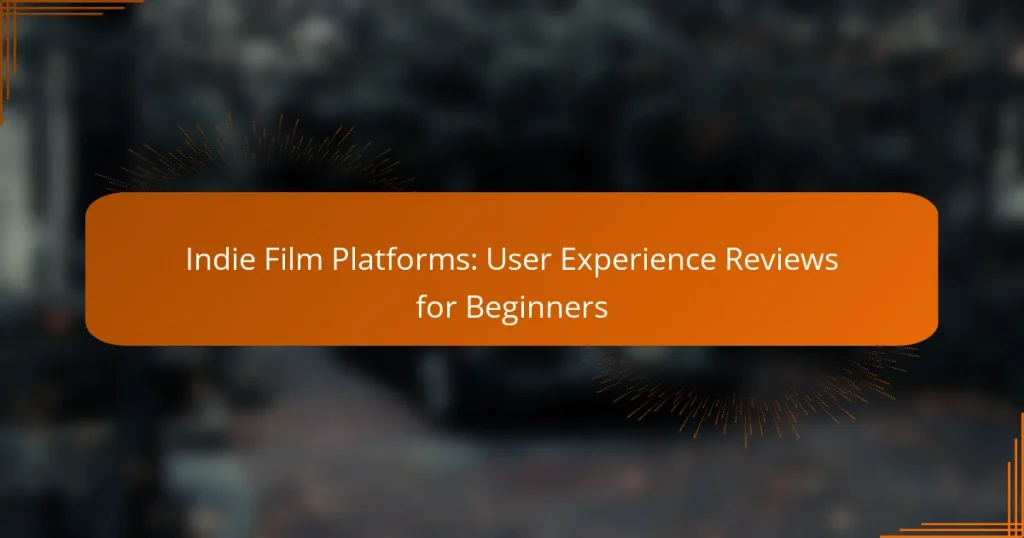Indie film platforms play a crucial role in connecting filmmakers with audiences, focusing on user experience to enhance this interaction. By offering intuitive navigation and effective content discovery, these platforms cater to the diverse needs of creators and viewers alike. Understanding the various features, pricing models, and community engagement options available can help beginners choose the best platform for their projects.

Which Indie Film Platforms Offer the Best User Experience?
Several indie film platforms excel in user experience, making it easier for filmmakers and audiences to connect. Key factors include intuitive navigation, streamlined processes, and effective content discovery.
Vimeo: Intuitive Interface
Vimeo is known for its clean and user-friendly interface, which allows users to easily upload, share, and discover films. The platform offers customizable video players and a straightforward upload process, making it accessible for beginners.
Users can create collections and playlists, enhancing the viewing experience. Additionally, Vimeo’s community features, such as comments and likes, foster engagement among filmmakers and viewers.
FilmFreeway: Streamlined Submission Process
FilmFreeway simplifies the film submission process for festivals, allowing filmmakers to submit their work with minimal hassle. The platform provides a centralized location for managing submissions, tracking deadlines, and receiving notifications.
With a user-friendly dashboard, filmmakers can easily navigate through various festivals and their requirements. This efficiency helps reduce the stress often associated with submitting to multiple festivals.
IndieFlix: Curated Content Discovery
IndieFlix focuses on curated content, making it easier for users to discover quality indie films. The platform features a diverse selection of films across genres, ensuring that viewers can find something that resonates with them.
Users can browse by categories or themes, and the platform often highlights new and trending films. This curated approach enhances the overall viewing experience and helps filmmakers reach their target audience.
Amazon Prime Video: Wide Audience Reach
Amazon Prime Video offers indie filmmakers a vast audience, providing significant exposure for their films. The platform allows filmmakers to distribute their content to millions of subscribers, increasing the chances of viewership and engagement.
While the interface may not be as specialized as other platforms, the sheer scale of Amazon’s audience can be a compelling reason for filmmakers to choose this option. However, competition is fierce, and filmmakers should focus on quality to stand out.
Seed&Spark: Community Engagement Features
Seed&Spark emphasizes community engagement, allowing filmmakers to connect with their audience directly. The platform offers features like crowdfunding, which enables creators to raise funds while building a supportive community around their projects.
Users can follow filmmakers, receive updates, and participate in discussions, fostering a sense of belonging. This engagement can be crucial for indie filmmakers looking to cultivate a loyal fan base and secure funding for future projects.

How Do Indie Film Platforms Compare in Features?
Indie film platforms vary significantly in features, catering to different needs of filmmakers and audiences. Key aspects include user interface, community engagement, distribution options, and monetization strategies, which can greatly influence user experience.
Vimeo vs. FilmFreeway: Key Differences
Vimeo focuses on high-quality video hosting and sharing, offering tools for filmmakers to showcase their work professionally. In contrast, FilmFreeway is primarily a submission platform for film festivals, allowing filmmakers to submit their projects easily and manage submissions in one place.
While Vimeo provides features like customizable portfolios and analytics, FilmFreeway emphasizes a streamlined submission process with access to thousands of festivals. Filmmakers should consider their primary goals—whether showcasing their work or entering festivals—when choosing between these platforms.
IndieFlix vs. Amazon Prime: User Engagement
IndieFlix is designed to foster community engagement, offering a subscription model that allows viewers to discover independent films while supporting filmmakers directly. The platform encourages interaction through features like curated collections and filmmaker Q&As.
Amazon Prime, on the other hand, has a vast library of content, including indie films, but its engagement features are less focused on community. Filmmakers may find that IndieFlix provides a more personal connection with audiences, while Amazon Prime offers broader reach but less direct interaction.
Seed&Spark vs. Vimeo: Community Focus
Seed&Spark prioritizes community building by connecting filmmakers with audiences through crowdfunding and social engagement. It offers tools for filmmakers to raise funds and build a following, making it a strong choice for those looking to cultivate a dedicated viewer base.
Vimeo, while also community-oriented, leans more towards showcasing finished projects rather than fostering ongoing relationships. Filmmakers seeking to engage with their audience and gather support for new projects may find Seed&Spark’s approach more beneficial than Vimeo’s emphasis on polished presentations.

What Are the Pricing Models for Indie Film Platforms?
Indie film platforms typically utilize various pricing models, including subscription fees, free submission options, and monthly charges. Understanding these models helps filmmakers choose the right platform based on their budget and distribution needs.
Vimeo: Subscription-Based Pricing
Vimeo operates on a subscription-based pricing model, offering several tiers that cater to different needs. Users can choose from Basic, Plus, Pro, Business, and Premium plans, with monthly fees ranging from approximately $7 to $75 USD, depending on features like storage limits and advanced analytics.
When selecting a plan, consider your film’s distribution strategy and audience engagement. Higher-tier plans provide additional tools for marketing and audience interaction, which can be beneficial for indie filmmakers looking to build a following.
FilmFreeway: Free Submission Options
FilmFreeway primarily offers free submission options for filmmakers to submit their projects to various film festivals. While the platform itself is free to use, festivals may charge submission fees that can vary widely, typically ranging from $10 to $100 USD.
Filmmakers should be aware that while submitting for free is appealing, festival fees can add up. It’s wise to research festivals and their reputations to ensure that your submissions are targeted and effective.
IndieFlix: Monthly Subscription Fees
IndieFlix charges a monthly subscription fee for viewers, typically around $5 to $10 USD, granting access to a library of independent films. This model allows filmmakers to earn revenue through viewer subscriptions, creating a potential income stream.
For filmmakers, partnering with IndieFlix can be advantageous as it provides exposure to a dedicated audience of indie film enthusiasts. However, consider the platform’s audience reach and how it aligns with your film’s genre and target demographic.

What User Experience Factors Should Beginners Consider?
Beginners should focus on content accessibility, user interface design, and community interaction when exploring indie film platforms. These factors significantly influence how easily users can find, navigate, and engage with films and fellow viewers.
Content Accessibility
Content accessibility refers to how easily users can find and consume films on a platform. Beginners should look for platforms that offer a wide range of genres and languages, as well as features like subtitles and audio descriptions. This ensures a more inclusive experience for diverse audiences.
Consider platforms that allow filtering by genre, release date, or viewer ratings. A good indie film platform should also provide clear information about content availability in your region, as licensing can vary significantly across countries.
User Interface Design
User interface design is crucial for a seamless viewing experience. A clean, intuitive layout helps beginners navigate the platform without confusion. Look for platforms that prioritize user-friendly navigation, such as easy-to-find search bars and straightforward categorization of films.
Pay attention to loading times and responsiveness. Platforms that load content quickly and adapt well to different devices, such as smartphones and tablets, enhance user satisfaction. Avoid platforms with cluttered designs or excessive ads, as these can detract from the viewing experience.
Community Interaction
Community interaction allows users to engage with other film enthusiasts, which can enrich the viewing experience. Look for platforms that offer features like forums, comment sections, or social media integration, enabling users to share opinions and recommendations.
Consider the level of moderation and support within the community. A positive, respectful environment encourages beginners to participate and share their thoughts. Platforms that host events, such as Q&A sessions with filmmakers, can also foster a sense of belonging and connection among users.

What Are the Common Challenges on Indie Film Platforms?
Indie film platforms often present several challenges that can hinder filmmakers’ success. These challenges include limited audience reach, technical issues during the uploading process, and intense competition among filmmakers.
Limited Audience Reach
Many indie film platforms struggle to attract a large or diverse audience. This limited reach can result from a lack of marketing resources or the platform’s niche focus, making it difficult for films to gain visibility.
Filmmakers should consider leveraging social media and online communities to promote their work. Engaging with potential viewers through targeted campaigns can help expand their audience beyond the platform’s built-in user base.
Technical Issues with Uploading
Uploading films to indie platforms can often be fraught with technical difficulties. Common problems include file format incompatibility, slow upload speeds, and issues with video quality after processing.
To mitigate these issues, filmmakers should familiarize themselves with the platform’s technical requirements before uploading. Preparing files in the recommended formats and conducting test uploads can save time and frustration.
Competition Among Filmmakers
The indie film space is highly competitive, with numerous filmmakers vying for attention on the same platforms. This saturation can make it challenging for individual films to stand out and attract viewers.
Filmmakers can differentiate their work by focusing on unique storytelling, high production quality, and effective marketing strategies. Collaborating with other creators and participating in film festivals can also enhance visibility and networking opportunities.


